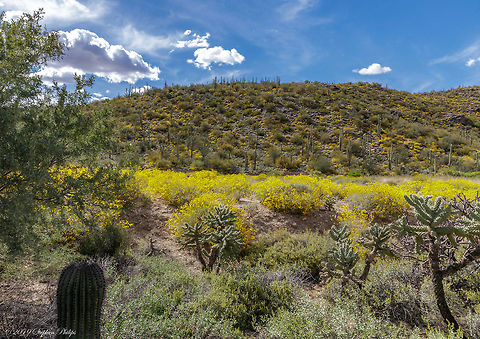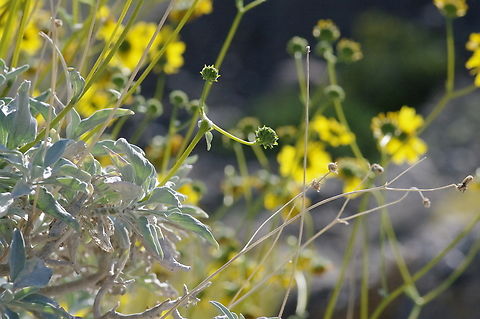
Appearance
Brittlebush grows up to 30 to 150 cm tall, with fragrant leaves 3–8 centimetres long, ovate to deltoid, and silvery tomentose. The capitula are 3.0–3.5 cm in diameter, with orange-yellow ray florets and yellow or purple-brown disc florets. They are arranged in loose panicles above the leafy stems fruit 3–6 mm and no pappus is visible.3-Acetyl-6-methoxybenzaldehyde is found in the leaves of "E. farinosa".

Naming
Other names include "hierba del vaso" and "cotx". Another Spanish name for it is "incienso" because the dried sap was burned by early Spanish missions in the New World as incense.
Habitat
"E. farinosa" can be found in a variety of habitats from dry, gravelly slopes to open, sandy washes up to 1,000 m. It requires a very sunny position in a deep very well-drained soil. It does well in cultivation often being used for border, erosion control, ground cover and massing and recently has spread dramatically in areas not natural to its distribution in large part because Caltrans has begun to use it in hydroseeding.Uses
Brittlebush has a long history of uses by indigenous and pioneer peoples.⤷ Glue: The resin collected from the base of the plant, yellowish to brown, can be heated and used as a glue. The O'odham and Seri use it for hafting, to hold points on arrows and harpoons.
⤷ Sealer: A different sort of resin collected from the upper stems is more gummy and generally a clear yellow. The Seri use this to seal pottery vessels.
⤷ Incense: Early Spanish friars learned that the resin made a highly fragrant incense, akin to frankincense in odor.
⤷ Gum: The Sells area Tohono O'odham children use upper stem resin as a passable chewing gum.
⤷ Toothbrush: Oldtime cowboys used brittlebush stem as a fine toothbrush.
⤷ Medicinal: Seri use brittlebush to treat toothache; the bark is removed, the branch heated in ashes, and then placed in the mouth to "harden" a loose tooth. The Cahuilla used brittlebush to treat toothaches as well, and used it as a chest pain reliever by heating the gum and applying it to the chest.
⤷ Waterproofing: It has been used to waterproof containers.
⤷ Varnish: It has been melted then used as a varnish.
References:
Some text fragments are auto parsed from Wikipedia.